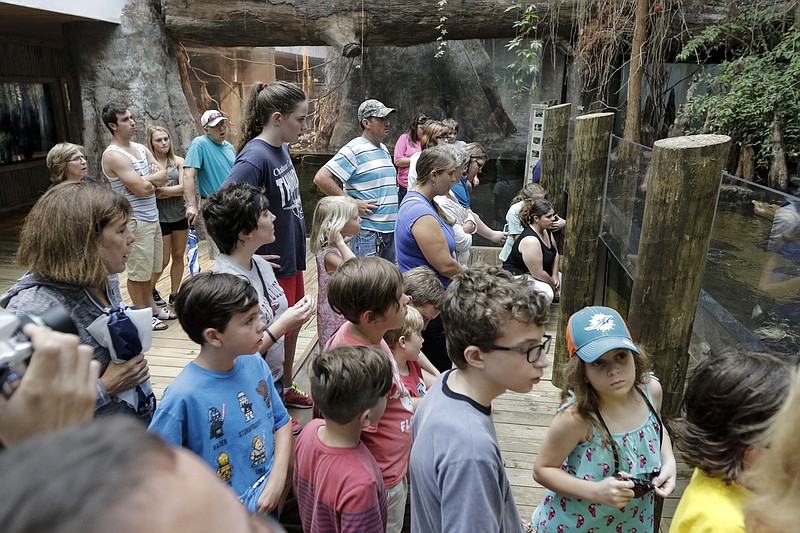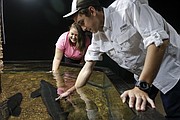After more than two decades, the Tennessee Aquarium is still helping power the Chattanooga economy, with a new study saying it generates $101.3 million a year.
"People are coming here, spending the night, eating in restaurants, doing multiple things while they're here and bringing their families," said aquarium President Charlie Arant. "That's why we get such a high economic impact."
The first detailed study of the tourist attraction's economic effect in about 20 years says the revenue fuels nearly 1,100 jobs in Hamilton County.
BY THE NUMBERS
$101.3M Aquarium's annual economic impact$67.7MAnnual goods and services bought by aquarium visitors from area businesses$2.2MFree student admissions and program support for education groups and nonprofits annually
Area businesses garner an estimated $67.7 million annually from goods and services bought by aquarium visitors, according to the study by the University of Tennessee Center for Sustainable Business and Development.
Last year, the nonprofit aquarium attracted 710,513 people. The average family visiting the attraction stayed at least one night and spent $709 in the county, including more than $450 on food and lodging alone, the report said.
The spending also results in $6.3 million in annual tax revenue, the study said.
In turn, Arant said, government has supported the tourism industry by plowing some of that money back into promotions.
Bob Doak, who heads the Chattanooga Convention and Visitors Bureau, said the aquarium "is a major driver of not just tourism but quality of life."
"It's a vital component," he said.
Arant estimated that up to 75 percent of aquarium visitors are not local people.
In 1992, its first year, the aquarium drew more than 1.1 million visitors - 50 percent more than planners had forecast. Visitation has slipped from those highs as similar attractions, such as in Atlanta and Gatlinburg, Tenn., have opened in the region and offered competition.
But, Arant said, the Tennessee Aquarium has continued to spend money on new and updated exhibits, even expanding to add the Ocean Journey building in 2005.
While the aquarium chief said no such expansion is on the drawing board, the facility's Delta Exhibit was totally revamped this year.
TAX RECEIPTS
The Tennessee Aquarium generates $6.3 million in annual tax revenue:› Sales tax: $4.9 million› Hotel tax: $900,000› Income tax: $500,000 Source: Aquarium study
"We'll keep the aquarium changing," Arant said. "We've got new exhibits we're working on or contemplating. We make changes every year or two years. When you're pulling people from a regional audience, you have to keep making changes to get people to come."
Sally Moses, an owner of the 212 Market restaurant near the aquarium, said her business still sees a lot of people wooed by the attraction.
"It's a huge part of downtown," she said. "It put a focus on the beauty of the river and getting folks to go to that site."
Tracy Easterly, manager of The Blue Plate eatery on Chestnut Street, said it gets a lot of its business from aquarium-goers, especially during the warmer months when tourism is heavy.
"It's a big attraction," she said, adding that she couldn't see Chattanooga without it.
Moses, whose restaurant was about the only business in the riverfront district before the aquarium, said Chattanooga would be "a less colorful place by far" with no such attraction.
Kim White, chief executive of the nonprofit downtown redevelopment group River City Co., cited the vision that originally conceived the aquarium as a possibility for Chattanooga and a catalyst for the central city's growth.
White said the aquarium is "the line in the sand" in regard to development in the city. Since it was built, she said, about $4.2 billion in private investment has come downtown.
Photo Gallery
Chattanooga's cash catalystNew study says Tennessee Aquarium has $101.3 million annual impact
"It totally changed the course of the way we do things in the city," White said.
The aquarium initially was envisioned in the late 1980s as a smaller facility to be built with private and public funds. At the urging of then-Gov. Lamar Alexander, organizers decided to make the facility the world's biggest freshwater aquarium.
With the backing of Jack Lupton, once owner of the largest Coca-Cola bottling empire in the world, the aquarium ultimately was privately funded, surrounded by a $10 million public park.
"It's been one heck of a ride," Arant said.
The study also looks at the social benefits of the aquarium, noting more than 3,000 teachers each year turn to the attraction for help in integrating environmental education into their lesson plans.
"We do a lot of things with education and school kids," Arant said, adding that more than 30,000 children are admitted free each year. "That's a big deal to us."
Arant said aquarium officials are asked about its impact on Chattanooga as they reach out to foundations for support, so they commissioned the analysis.
"Foundations ask, 'What difference are you making? How do you quantify what you're doing?'" he said. "We'll use [the study] extensively to tell our story and justify how we're doing."
Contact Mike Pare at mpare@timesfreepress.com or 423-757-6318.

